Spatially Multiplexed Micro-Spectrophotometry in Bright Field Mode for Thin Film Characterization
Abstract
:1. Introduction
2. Experimental Details
2.1. Spatially Multiplexed Micro-Spectrophotometry (SMMS) in Bright Field Mode
2.2. Bright Field Spectral Analysis of Commercial Cantilevers
3. Results and Discussion
3.1. Cantilever Thickness Mapping
3.2. Effect of Thickness Variability on Microcantilever Mechanical Properties
4. Conclusions
Acknowledgments
Author Contributions
Conflicts of Interest
Appendix A: Raw Data Normalization
Appendix B: Finite Element Analysis of Cantilevers with Thickness Inhomogeneity.
References
- Van Zant, P. Microchip Fabrication: A Practical Guide to Semiconductor Processing; McGraw-Hill: New York, NY, USA, 2000. [Google Scholar]
- Heavens, O.S. Optical Properties of Thin Solid Films; Courier Corporation: North Chelmsford, MA, USA, 1991. [Google Scholar]
- Bates, J.; Dudney, N.; Neudecker, B.; Ueda, A.; Evans, C. Thin-film lithium and lithium-ion batteries. Solid State Ion. 2000, 135, 33–45. [Google Scholar] [CrossRef]
- Aberle, A.G. Thin-film solar cells. Thin Solid Films 2009, 517, 4706–4710. [Google Scholar] [CrossRef]
- Anja, B.; Søren, D.; Stephan Sylvest, K.; Silvan, S.; Maria, T. Cantilever-like micromechanical sensors. Rep. Prog. Phys. 2011, 74, 036101. [Google Scholar]
- Azzam, R.M.A.; Bashara, N.M. Ellipsometry and Polarized Light; North-Holland: New York, NY, USA, 1977. [Google Scholar]
- Hauge, P.S. Recent developments in instrumentation in ellipsometry. Surf. Sci. 1980, 96, 108–140. [Google Scholar] [CrossRef]
- Erman, M.; Theeten, J.B. Spatially resolved ellipsometry. J. Appl. Phys. 1986, 60, 859–873. [Google Scholar] [CrossRef]
- Ghim, Y.-S.; Kim, S.-W. Spectrally resolved white-light interferometry for 3D inspection of a thin-film layer structure. Appl. Opt. 2009, 48, 799–803. [Google Scholar] [CrossRef] [PubMed]
- Ghim, Y.-S.; Rhee, H.-G.; Yang, H.-S.; Lee, Y.-W. Thin-film thickness profile measurement using a Mirau-type low-coherence interferometer. Meas. Sci. Technol. 2013, 24, 075002. [Google Scholar] [CrossRef]
- Wu, K.; Lee, C.-C.; Brock, N.J.; Kimbrough, B. Multilayer thin-film inspection through measurements of reflection coefficients. Opt. Lett. 2011, 36, 3269–3271. [Google Scholar] [CrossRef] [PubMed]
- Kim, S.W.; Kim, G.H. Thickness-profile measurement of transparent thin-film layers by white-light scanning interferometry. Appl. Opt. 1999, 38, 5968–5973. [Google Scholar] [CrossRef] [PubMed]
- Kim, D.; Kim, S.; Kong, H.J.; Lee, Y. Measurement of the thickness profile of a transparent thin film deposited upon a pattern structure with an acousto-optic tunable filter. Opt. Lett. 2002, 27, 1893–1895. [Google Scholar] [CrossRef] [PubMed]
- Debnath, S.K.; Kothiyal, M.P.; Schmit, J.; Hariharan, P. Spectrally resolved white-light phase-shifting interference microscopy for thickness-profile measurements of transparent thin film layers on patterned substrates. Opt. Express 2006, 14, 4662–4667. [Google Scholar] [CrossRef] [PubMed]
- Ghim, Y.S.; Kim, S.W. Thin-film thickness profile and its refractive index measurements by dispersive white-light interferometry. Opt. Express 2006, 14, 11885–11891. [Google Scholar] [CrossRef] [PubMed]
- Dong, J.T.; Lu, R.S. Sensitivity analysis of thin-film thickness measurement by vertical scanning white-light interferometry. Appl. Opt. 2012, 51, 5668–5675. [Google Scholar] [CrossRef] [PubMed]
- Martin, P.C.; Eyring, M.B. Chapter 13: Microspectrophotometry. In Experimental Methods in the Physical Sciences; Thomas, A., Germer, J.C.Z., Benjamin, K.T., Eds.; Academic Press: Cambridge, MA, USA, 2014; Volume 46, pp. 489–517. [Google Scholar]
- Scholz, T.; Debski, T.; Barth, W.; Römer, F.; Hillmer, H. A high-resolution optical study of cantilever heterostructure layer geometries. J. Micromech. Microeng. 2006, 16, 2765–2770. [Google Scholar] [CrossRef]
- Salmon, A.R.; Capener, M.J.; Baumberg, J.J.; Elliott, S.R. Rapid microcantilever-thickness determination by optical interferometry. Meas. Sci. Technol. 2014, 25, 015202. [Google Scholar] [CrossRef]
- Ghim, Y.-S.; Kim, S.-W. Fast, precise, tomographic measurements of thin films. Appl. Phys. Lett. 2007, 91, 091903. [Google Scholar] [CrossRef]
- Hlubina, P.; Luňáček, J.; Ciprian, D.; Chlebus, R. Spectral interferometry and reflectometry used to measure thin films. Appl. Phys. B Lasers Opt. 2008, 92, 203–207. [Google Scholar] [CrossRef]
- Hirth, F.; Buck, T.C.; Grassi, A.P.; Koch, A.W. Depth-sensitive thin film reflectometer. Meas. Sci. Technol. 2010, 21, 125301. [Google Scholar] [CrossRef]
- Reed, J.; Wilkinson, P.; Schmit, J.; Klug, W.; Gimzewski, J.K. Observation of nanoscale dynamics in cantilever sensor arrays. Nanotechnology 2006, 17, 3873–3879. [Google Scholar] [CrossRef]
- Pini, V.; Kosaka, P.M.; Ruz, J.J.; Malvar, O.; Encinar, M.; Tamayo, J.; Calleja, M. Spatially multiplexed dark-field microspectrophotometry for nanoplasmonics. Sci. Rep. 2016, 6, 22836. [Google Scholar] [CrossRef] [PubMed]
- Calleja, M.; Kosaka, P.M.; San Paulo, Á.; Tamayo, J. Challenges for nanomechanical sensors in biological detection. Nanoscale 2012, 4, 4925–4938. [Google Scholar] [CrossRef] [PubMed]
- Tamayo, J.; Kosaka, P.M.; Ruz, J.J.; San Paulo, A.; Calleja, M. Biosensors based on nanomechanical systems. Chem. Soc. Rev. 2013, 42, 1287–1311. [Google Scholar] [CrossRef] [PubMed]
- Clifford, C.A.; Seah, M.P. Improved methods and uncertainty analysis in the calibration of the spring constant of an atomic force microscope cantilever using static experimental methods. Meas. Sci. Technol. 2009, 20, 125501. [Google Scholar] [CrossRef]
- Webber, G.B.; Stevens, G.W.; Grieser, F.; Dagastine, R.R.; Chan, D.Y.C. Variations in properties of atomic force microscope cantilevers fashioned from the same wafer. Nanotechnology 2008, 19, 105709. [Google Scholar] [CrossRef] [PubMed]
- Wilkinson, P.R.; Gimzewski, J.K. Thin film interference in the optomechanical response of micromechanical silicon cantilevers. Appl. Phys. Lett. 2006, 89, 241916. [Google Scholar] [CrossRef]
- Gomez-Martinez, R.; Hernandez-Pinto, A.M.; Duch, M.; Vazquez, P.; Zinoviev, K.; de la Rosa, E.J.; Esteve, J.; Suarez, T.; Plaza, J.A. Silicon chips detect intracellular pressure changes in living cells. Nat. Nanotechnol. 2013, 8, 517–521. [Google Scholar] [CrossRef] [PubMed]
- Llorens, J.M.; Buencuerpo, J.; Postigo, P.A. Absorption features of the zero frequency mode in an ultra-thin slab. Appl. Phys. Lett. 2014, 105, 231115. [Google Scholar] [CrossRef]
- Born, M.; Wolf, E. Principles of Optics: Electromagnetic Theory of Propagation, Interference and Diffraction of Light; CUP Archive: Cambridge, UK, 1999. [Google Scholar]
- Vuye, G.; Fisson, S.; Nguyen Van, V.; Wang, Y.; Rivory, J.; Abeles, F. Temperature dependence of the dielectric function of silicon using in situ spectroscopic ellipsometry. Thin Solid Films 1993, 233, 166–170. [Google Scholar] [CrossRef]
- Cowan, G. Statistical Data Analysis; Oxford University Press: Oxford, UK, 1998. [Google Scholar]
- Charles, A.C.; Martin, P.S. The determination of atomic force microscope cantilever spring constants via dimensional methods for nanomechanical analysis. Nanotechnology 2005, 16, 1666. [Google Scholar]
- Tamayo, J.; Ruz, J.J.; Pini, V.; Kosaka, P.; Calleja, M. Quantification of the surface stress in microcantilever biosensors: Revisiting Stoney’s equation. Nanotechnology 2012, 23, 475702. [Google Scholar] [CrossRef] [PubMed]
- Ramos, D.; Calleja, M.; Mertens, J.; Zaballos, Á.; Tamayo, J. Measurement of the mass and rigidity of adsorbates on a microcantilever sensor. Sensors 2007, 7, 1834–1845. [Google Scholar] [CrossRef]
- Ruz, J.; Tamayo, J.; Pini, V.; Kosaka, P.; Calleja, M. Physics of nanomechanical spectrometry of viruses. Sci. Rep. 2014, 4. [Google Scholar] [CrossRef] [PubMed]
- McKendry, R.; Zhang, J.; Arntz, Y.; Strunz, T.; Hegner, M.; Lang, H.P.; Baller, M.K.; Certa, U.; Meyer, E.; Güntherodt, H.-J.; et al. Multiple label-free biodetection and quantitative DNA-binding assays on a nanomechanical cantilever array. Proc. Natl. Acad. Sci. USA 2002, 99, 9783–9788. [Google Scholar] [CrossRef] [PubMed]
- Lang, H.P.; Hegner, M.; Gerber, C. Cantilever array sensors. Mater. Today 2005, 8, 30–36. [Google Scholar] [CrossRef]
- Lang, H.P.; Berger, R.; Andreoli, C.; Brugger, J.; Despont, M.; Vettiger, P.; Gerber, C.; Gimzewski, J.K.; Ramseyer, J.P.; Meyer, E.; et al. Sequential position readout from arrays of micromechanical cantilever sensors. Appl. Phys. Lett. 1998, 72, 383–385. [Google Scholar] [CrossRef]
- Domínguez, C.M.; Kosaka, P.M.; Mokry, G.; Pini, V.; Malvar, O.; del Rey, M.; Ramos, D.; San Paulo, Á.; Tamayo, J.; Calleja, M. Hydration Induced Stress on DNA Monolayers Grafted on Microcantilevers. Langmuir 2014, 30, 10962–10969. [Google Scholar] [CrossRef] [PubMed]
- Zhang, J.; Lang, H.P.; Huber, F.; Bietsch, A.; Grange, W.; Certa, U.; McKendry, R.; Guntherodt, H.J.; Hegner, M.; Gerber, C. Rapid and label-free nanomechanical detection of biomarker transcripts in human RNA. Nat. Nanotechnol. 2006, 1, 214–220. [Google Scholar] [CrossRef] [PubMed]
- Martínez, N.; Kosaka, P.M.; Tamayo, J.; Ramírez, J.; Ahumada, O.; Mertens, J.; Hien, T.; Rijn, C.; Calleja, M. High throughput optical readout of dense arrays of nanomechanical systems for sensing applications. Rev. Sci. Instrum. 2010, 81, 125109. [Google Scholar] [CrossRef] [PubMed]
- Kosaka, P.M.; Tamayo, J.; Ruz, J.J.; Puertas, S.; Polo, E.; Grazu, V.; Jesús, M.; Calleja, M. Tackling reproducibility in microcantilever biosensors: A statistical approach for sensitive and specific end-point detection of immunoreactions. Analyst 2013, 138, 863–872. [Google Scholar] [CrossRef] [PubMed]
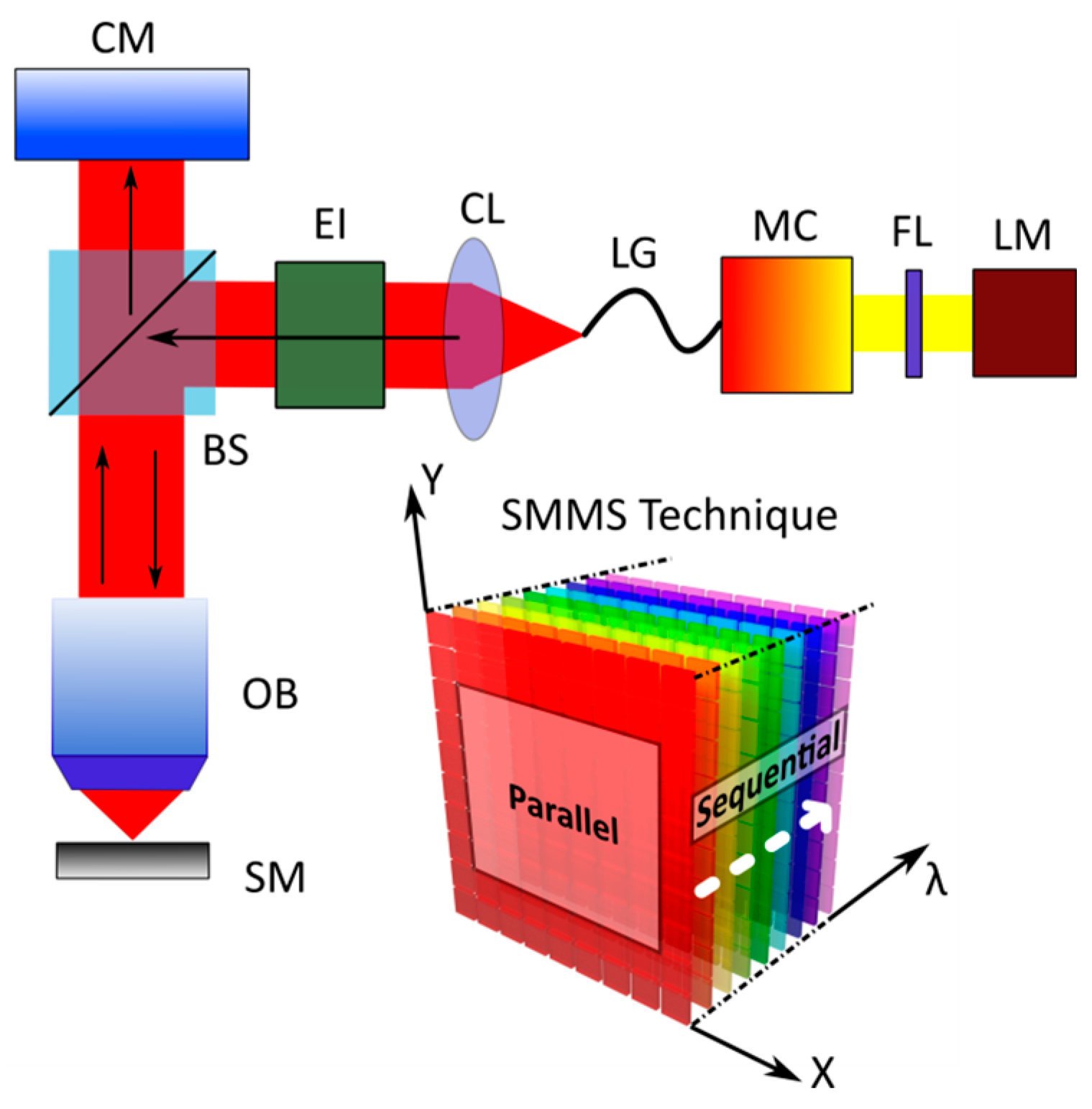
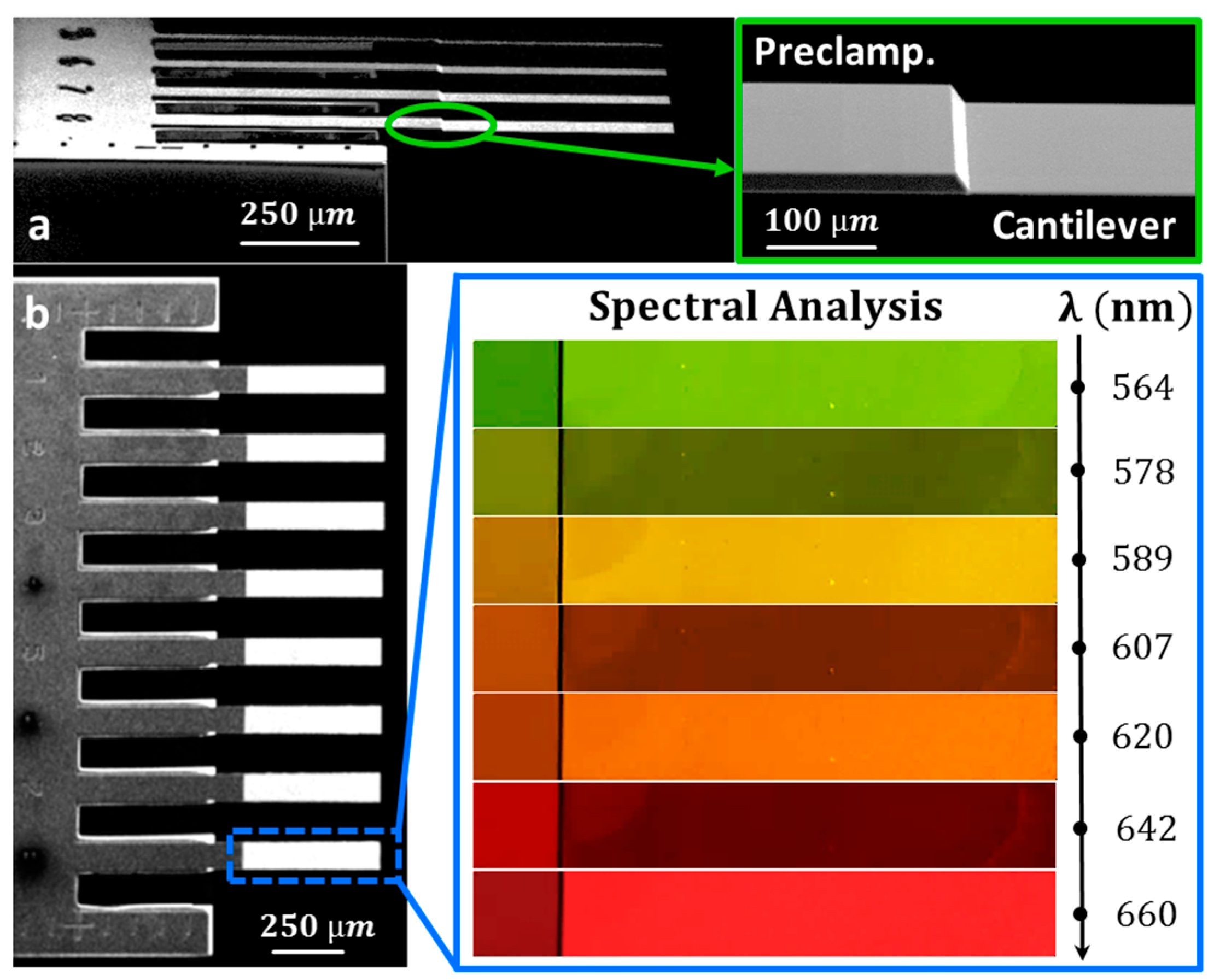
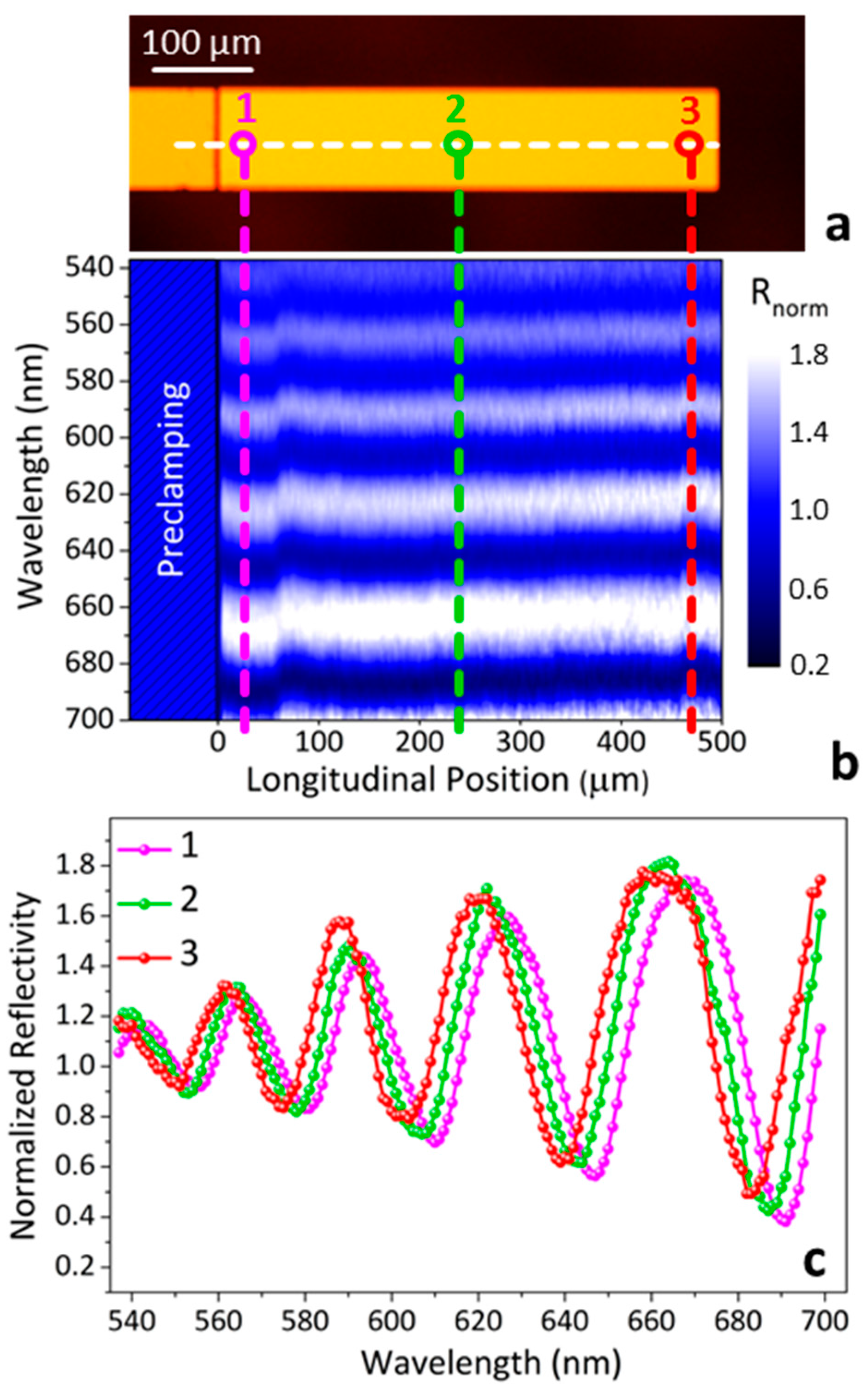
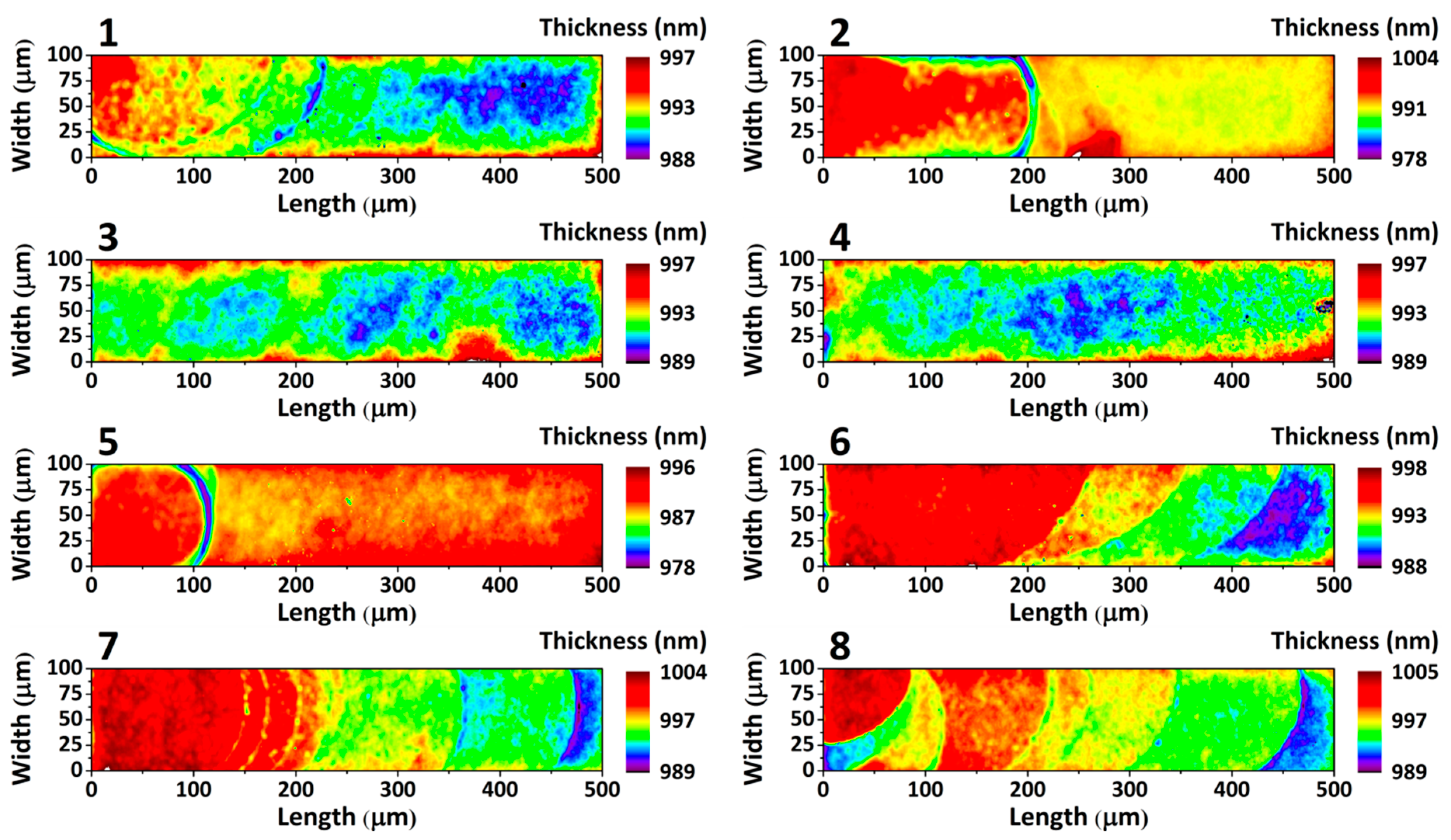
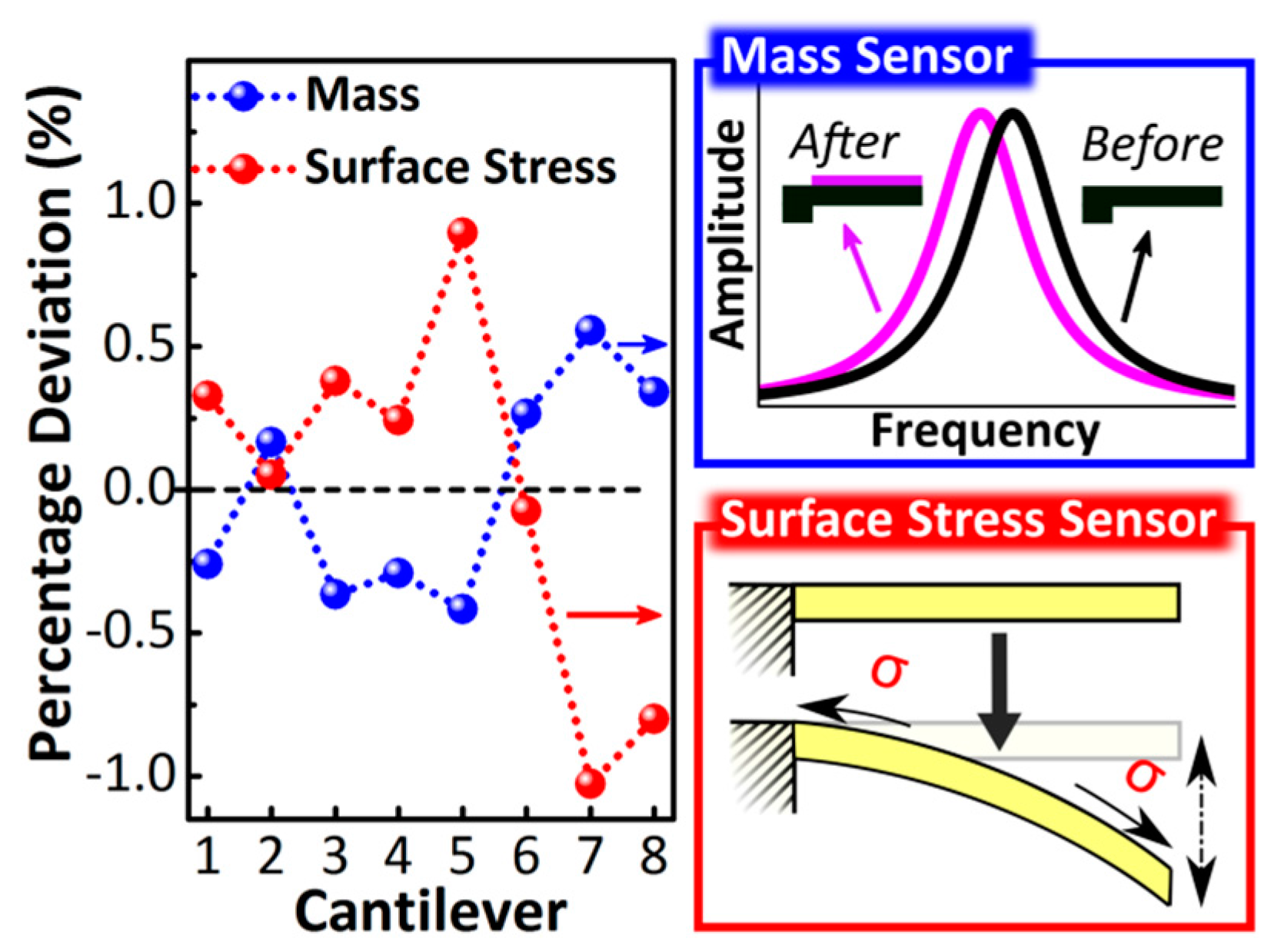
© 2016 by the authors; licensee MDPI, Basel, Switzerland. This article is an open access article distributed under the terms and conditions of the Creative Commons Attribution (CC-BY) license (http://creativecommons.org/licenses/by/4.0/).
Share and Cite
Pini, V.; Kosaka, P.M.; Ruz, J.J.; Malvar, O.; Encinar, M.; Tamayo, J.; Calleja, M. Spatially Multiplexed Micro-Spectrophotometry in Bright Field Mode for Thin Film Characterization. Sensors 2016, 16, 926. https://doi.org/10.3390/s16060926
Pini V, Kosaka PM, Ruz JJ, Malvar O, Encinar M, Tamayo J, Calleja M. Spatially Multiplexed Micro-Spectrophotometry in Bright Field Mode for Thin Film Characterization. Sensors. 2016; 16(6):926. https://doi.org/10.3390/s16060926
Chicago/Turabian StylePini, Valerio, Priscila M. Kosaka, Jose J. Ruz, Oscar Malvar, Mario Encinar, Javier Tamayo, and Montserrat Calleja. 2016. "Spatially Multiplexed Micro-Spectrophotometry in Bright Field Mode for Thin Film Characterization" Sensors 16, no. 6: 926. https://doi.org/10.3390/s16060926
APA StylePini, V., Kosaka, P. M., Ruz, J. J., Malvar, O., Encinar, M., Tamayo, J., & Calleja, M. (2016). Spatially Multiplexed Micro-Spectrophotometry in Bright Field Mode for Thin Film Characterization. Sensors, 16(6), 926. https://doi.org/10.3390/s16060926









